Capital One 2012 Annual Report Download - page 222
Download and view the complete annual report
Please find page 222 of the 2012 Capital One annual report below. You can navigate through the pages in the report by either clicking on the pages listed below, or by using the keyword search tool below to find specific information within the annual report.-
 1
1 -
 2
2 -
 3
3 -
 4
4 -
 5
5 -
 6
6 -
 7
7 -
 8
8 -
 9
9 -
 10
10 -
 11
11 -
 12
12 -
 13
13 -
 14
14 -
 15
15 -
 16
16 -
 17
17 -
 18
18 -
 19
19 -
 20
20 -
 21
21 -
 22
22 -
 23
23 -
 24
24 -
 25
25 -
 26
26 -
 27
27 -
 28
28 -
 29
29 -
 30
30 -
 31
31 -
 32
32 -
 33
33 -
 34
34 -
 35
35 -
 36
36 -
 37
37 -
 38
38 -
 39
39 -
 40
40 -
 41
41 -
 42
42 -
 43
43 -
 44
44 -
 45
45 -
 46
46 -
 47
47 -
 48
48 -
 49
49 -
 50
50 -
 51
51 -
 52
52 -
 53
53 -
 54
54 -
 55
55 -
 56
56 -
 57
57 -
 58
58 -
 59
59 -
 60
60 -
 61
61 -
 62
62 -
 63
63 -
 64
64 -
 65
65 -
 66
66 -
 67
67 -
 68
68 -
 69
69 -
 70
70 -
 71
71 -
 72
72 -
 73
73 -
 74
74 -
 75
75 -
 76
76 -
 77
77 -
 78
78 -
 79
79 -
 80
80 -
 81
81 -
 82
82 -
 83
83 -
 84
84 -
 85
85 -
 86
86 -
 87
87 -
 88
88 -
 89
89 -
 90
90 -
 91
91 -
 92
92 -
 93
93 -
 94
94 -
 95
95 -
 96
96 -
 97
97 -
 98
98 -
 99
99 -
 100
100 -
 101
101 -
 102
102 -
 103
103 -
 104
104 -
 105
105 -
 106
106 -
 107
107 -
 108
108 -
 109
109 -
 110
110 -
 111
111 -
 112
112 -
 113
113 -
 114
114 -
 115
115 -
 116
116 -
 117
117 -
 118
118 -
 119
119 -
 120
120 -
 121
121 -
 122
122 -
 123
123 -
 124
124 -
 125
125 -
 126
126 -
 127
127 -
 128
128 -
 129
129 -
 130
130 -
 131
131 -
 132
132 -
 133
133 -
 134
134 -
 135
135 -
 136
136 -
 137
137 -
 138
138 -
 139
139 -
 140
140 -
 141
141 -
 142
142 -
 143
143 -
 144
144 -
 145
145 -
 146
146 -
 147
147 -
 148
148 -
 149
149 -
 150
150 -
 151
151 -
 152
152 -
 153
153 -
 154
154 -
 155
155 -
 156
156 -
 157
157 -
 158
158 -
 159
159 -
 160
160 -
 161
161 -
 162
162 -
 163
163 -
 164
164 -
 165
165 -
 166
166 -
 167
167 -
 168
168 -
 169
169 -
 170
170 -
 171
171 -
 172
172 -
 173
173 -
 174
174 -
 175
175 -
 176
176 -
 177
177 -
 178
178 -
 179
179 -
 180
180 -
 181
181 -
 182
182 -
 183
183 -
 184
184 -
 185
185 -
 186
186 -
 187
187 -
 188
188 -
 189
189 -
 190
190 -
 191
191 -
 192
192 -
 193
193 -
 194
194 -
 195
195 -
 196
196 -
 197
197 -
 198
198 -
 199
199 -
 200
200 -
 201
201 -
 202
202 -
 203
203 -
 204
204 -
 205
205 -
 206
206 -
 207
207 -
 208
208 -
 209
209 -
 210
210 -
 211
211 -
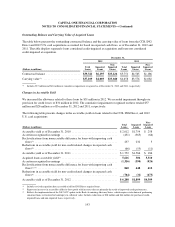 212
212 -
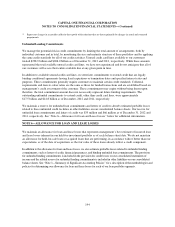 213
213 -
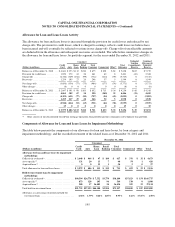 214
214 -
 215
215 -
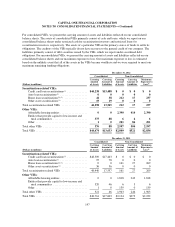 216
216 -
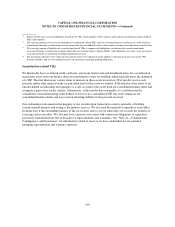 217
217 -
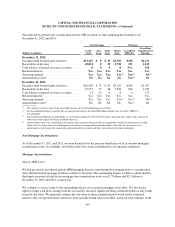 218
218 -
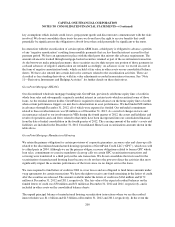 219
219 -
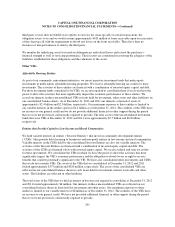 220
220 -
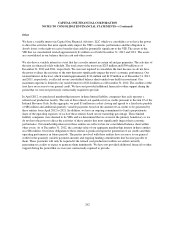 221
221 -
 222
222 -
 223
223 -
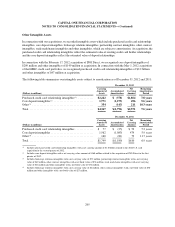 224
224 -
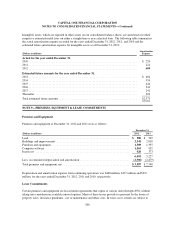 225
225 -
 226
226 -
 227
227 -
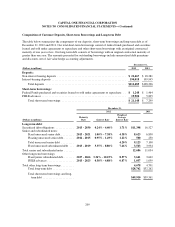 228
228 -
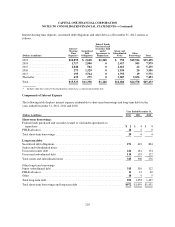 229
229 -
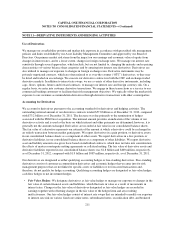 230
230 -
 231
231 -
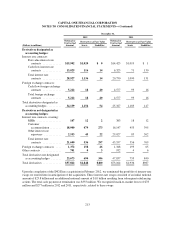 232
232 -
 233
233 -
 234
234 -
 235
235 -
 236
236 -
 237
237 -
 238
238 -
 239
239 -
 240
240 -
 241
241 -
 242
242 -
 243
243 -
 244
244 -
 245
245 -
 246
246 -
 247
247 -
 248
248 -
 249
249 -
 250
250 -
 251
251 -
 252
252 -
 253
253 -
 254
254 -
 255
255 -
 256
256 -
 257
257 -
 258
258 -
 259
259 -
 260
260 -
 261
261 -
 262
262 -
 263
263 -
 264
264 -
 265
265 -
 266
266 -
 267
267 -
 268
268 -
 269
269 -
 270
270 -
 271
271 -
 272
272 -
 273
273 -
 274
274 -
 275
275 -
 276
276 -
 277
277 -
 278
278 -
 279
279 -
 280
280 -
 281
281 -
 282
282 -
 283
283 -
 284
284 -
 285
285 -
 286
286 -
 287
287 -
 288
288 -
 289
289 -
 290
290 -
 291
291 -
 292
292 -
 293
293 -
 294
294 -
 295
295 -
 296
296 -
 297
297 -
 298
298 -
 299
299 -
 300
300 -
 301
301 -
 302
302 -
 303
303 -
 304
304 -
 305
305 -
 306
306 -
 307
307 -
 308
308 -
 309
309 -
 310
310 -
 311
311
 |
 |

CAPITAL ONE FINANCIAL CORPORATION
NOTES TO CONSOLIDATED FINANCIAL STATEMENTS—(Continued)
NOTE 8—GOODWILL AND OTHER INTANGIBLE ASSETS
The table below displays the components of goodwill and other intangible assets, as of December 31, 2012 and
2011:
December 31,
(Dollars in millions) 2012(1) 2011
Goodwill .................................................................. $13,904 $13,592
Other intangible assets:
Purchased credit card relationship intangibles ................................. 1,864 52
Core deposit intangibles .................................................. 496 479
Other ................................................................. 211 79
Total other intangible assets ................................................... 2,571 610
Total goodwill and other intangible assets ........................................ $16,475 $14,202
(1) December 31, 2012 amounts include goodwill and intangibles related to the 2012 U.S. card acquisition in the second quarter of 2012 and
intangibles related to the acquisition of ING Direct in the first quarter of 2012.
Goodwill
In accordance with applicable accounting guidance, goodwill is not amortized but is tested for impairment at the
reporting unit level, which is at the operating segment level or one level below an operating segment. Impairment
is the condition that exists when the carrying amount of goodwill exceeds its implied fair value. Goodwill is
required to be tested for impairment annually and between annual tests if events or circumstances change, such as
adverse changes in the business climate, that would more likely than not reduce the fair value of the reporting
unit below its carrying value. Goodwill is assigned to one or more reporting units at the date of acquisition. Our
reporting units are Domestic Credit Card, International Credit Card, Auto Finance, other Consumer
Banking and Commercial Banking. As of December 31, 2012 and 2011, goodwill of $13.9 billion and $13.6
billion, respectively, was included in the accompanying consolidated balance sheets. The goodwill impairment
test, performed at October 1 of each year, is a two-step test. The first step identifies whether there is potential
impairment by comparing the fair value of a reporting unit to the carrying amount, including goodwill. If the fair
value of a reporting unit is less than its carrying amount, the second step of the impairment test is required to
measure the amount of any impairment loss.
During the second quarter of 2012, we acquired the assets and assumed the liabilities of the credit card and
private label credit card business of HSBC. In connection with the acquisition, we recorded goodwill of $304
million representing the amount by which the purchase price exceeded the fair value of the net assets acquired.
The goodwill was assigned to the Credit Card segment. See “Note 2—Acquisitions” for information regarding
the 2012 U.S. card acquisition.
For the 2012 annual impairment test, the fair value of reporting units was calculated using a discounted cash flow
analysis, a form of the income approach, using each reporting unit’s internal forecast and a terminal value
calculated using a growth rate reflecting the nominal growth rate of the economy as a whole and appropriate
discount rates for the respective reporting units. Cash flows were adjusted, as necessary, in order to maintain
each reporting unit’s equity capital requirements. Our discounted cash flow analysis required management to
make judgments about future loan and deposit growth, revenue growth, credit losses, and capital rates. The cash
flows were discounted to present value using reporting unit specific discount rates that are largely based on our
203
